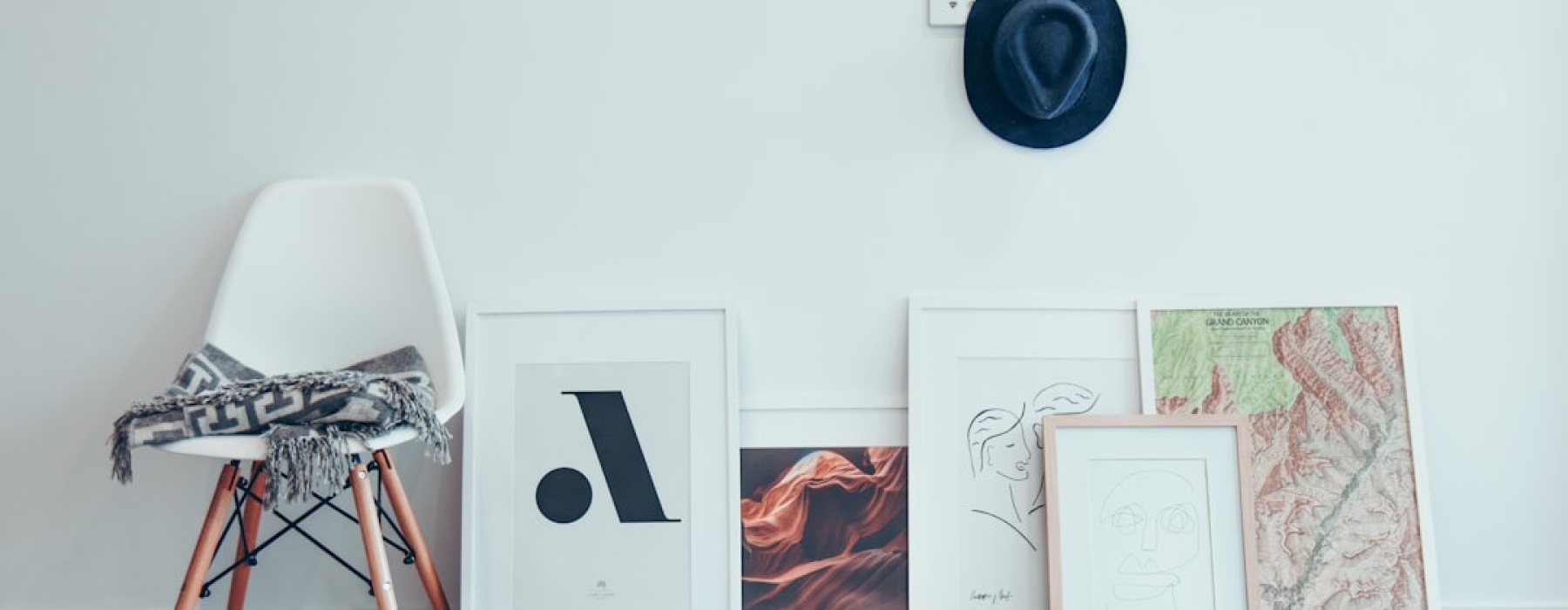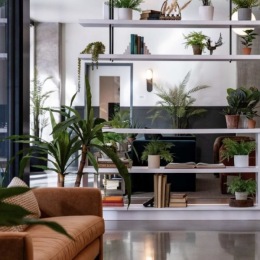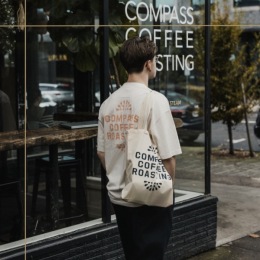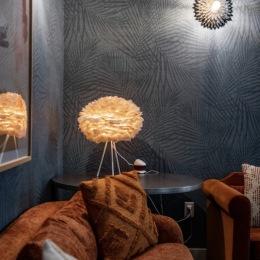Changing Your Small Space: The Modern Design Approach
Living in a compact apartment doesn't mean compromising on style or comfort. Modern interior design ideas for small apartments transform limitations into opportunities, creating spaces that feel both spacious and stylish. When every square foot matters, thoughtful design becomes your secret weapon.
The beauty of small-space design lies in its creative challenge. That studio apartment at The Miller can become a sophisticated haven with the right approach. Compact living has even become something of a movement, with Pinterest reporting that searches for "small apartment decorating" jumped by over 80% in 2023.
What makes modern small-space design so effective? It's about working smarter, not harder. Multifunctional furniture like storage ottomans and Murphy beds pull double duty, while vertical thinking takes advantage of often-overlooked wall space. Light-enhancing tricks using mirrors and metallics can visually double your space—a fact confirmed by design experts at The Spruce.
"Function can still be fashionable." - Laurel McManus Brown, Interior Designer
The most successful small apartments use space-defining techniques to create distinct areas without walls. A well-placed area rug or lightweight divider can transform one room into multiple zones. Meanwhile, visual expansion through light color palettes makes rooms feel airier and more open.
Starting with a clear plan is crucial. When space is limited, impulse purchases often lead to clutter and dysfunction. Today's small-space dwellers—whether in downtown Vancouver or at The Miller's waterfront apartments—find that limitations often spark the most personalized, creative designs.
When thoughtfully executed, a small apartment becomes not just a place to live, but a reflection of smart, intentional choices. The satisfaction of creating a space that works perfectly for your needs while looking stunning is what makes small apartment design so rewarding.
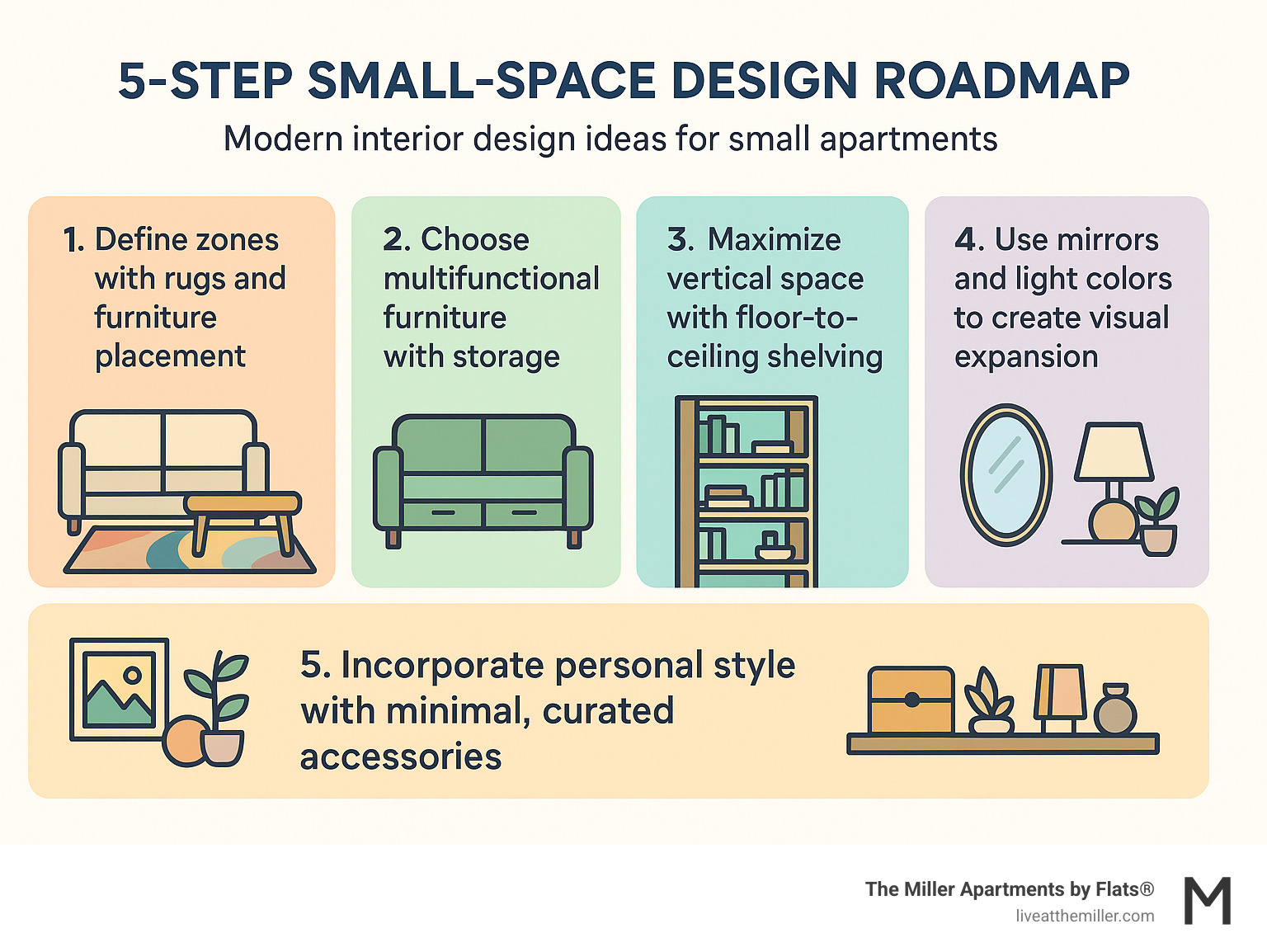
Modern Interior Design Ideas for Small Apartments: Quick-Start Checklist
Ready to transform your compact space? Let's start with the essentials. Think of this checklist as your foundation for creating a stylish, functional small apartment that feels anything but cramped.
First things first: declutter ruthlessly. In small spaces, every item needs to earn its keep. If it doesn't serve a purpose or bring you joy, it's probably time to let it go. Your apartment will instantly feel more spacious when it's not crowded with unnecessary items.
Next, focus on zoning your space. Even in the tiniest studio, you can create visual boundaries between your sleeping, working, and relaxation areas. This mental separation helps your apartment feel more like a complete home rather than just one room.
Multifunctional furniture is your best friend in a small apartment. Why settle for a coffee table that's just a coffee table when you could have one with hidden storage? According to Apartment Therapy, 67% of their readers rely on multifunctional pieces to maximize their small spaces—clearly a strategy that works!
Don't shy away from light palettes. Whites, creams, and soft neutrals visually push walls outward and ceilings upward, creating an airy feeling that darker colors simply can't match.
Incorporate mirrors and metallics throughout your space. These reflective surfaces bounce light around the room, tricking the eye into perceiving more space than actually exists.
When floor space is at a premium, think upward. Vertical storage solutions like tall bookshelves and wall-mounted organizers take advantage of often-overlooked wall real estate.
Finally, accept renter-friendly hacks like removable wallpaper, temporary fixtures, and freestanding solutions that won't jeopardize your security deposit when it's time to move.
Modern interior design ideas for small apartments: layout case studies
Open-plan studios present both challenges and creative opportunities. In these spaces, maintaining clear sight lines across the room creates an unobstructed view that instantly makes your apartment feel more expansive.
Consider this real-world example: A 375-square-foot studio in Vancouver was completely transformed by defining three distinct zones using area rugs and strategic furniture placement rather than walls. The result? A space that felt purposeful and organized instead of cramped and chaotic.
When browsing potential apartments, pay attention to the shape of the rooms. Rectangular spaces often work better than square ones for creating natural divisions. As you explore The Miller's floor plans, look for layouts with built-in alcoves or natural divisions that can help define different functional areas.
Modern interior design ideas for small apartments: color & lighting snapshots
Light neutrals form the backbone of successful small-space design. Real Simple reports that choosing light colors for walls and floors can make a small apartment feel up to 30% brighter and more spacious—a dramatic difference in limited square footage!
But don't think "neutral" means "boring." Bold accents can actually improve your space by creating focal points that draw attention away from the room's size. Try following the 70-30 rule: 70% neutral tones with 30% accent colors for a balanced, visually interesting space.
Layered lighting is absolutely essential in small apartments. Rather than relying on a single overhead light that creates harsh shadows, incorporate a mix of task lighting for specific activities, ambient lighting for overall illumination, and accent lighting to highlight your favorite features or artwork. This approach not only makes your space more functional but also creates depth and dimension that can make rooms feel larger than they are.
1. Space-Savvy Layouts & Zoning Tricks
The foundation of any small apartment change starts with a smart layout. How you arrange your furniture can make the difference between a cramped space and one that feels open and inviting.
Here's a surprising tip that really works: try floating your sofa in the center of the room instead of pushing it against a wall. This counter-intuitive move actually creates better flow around your furniture and helps define separate areas in an open floor plan. At The Miller, our residents often find that this simple shift completely transforms how their space functions.
"Embracing light and neutral colors is a design secret that can transform a cramped space into an open oasis," shares designer Andrea Wells. But creating distinct zones isn't just about color – strategic furniture placement plays an equally important role.
Did you know that mounting your TV on the wall instead of using a media console can free up to 10 square feet of floor space? According to House Beautiful, these small changes add up significantly in compact apartments. When every square foot counts, these details matter!
When planning your layout, keep these practical guidelines in mind:
- Allow at least 18 inches between seating and tables for comfortable movement
- Maintain 3 feet for main walkways through your space
- Keep sight lines clear across the room whenever possible
- Consider pocket doors with glass panels instead of traditional swinging doors to save space while maintaining light flow
![Image of taped-out zones on floor showing how to plan a layout before moving furniture]
Create Distinct Zones in a Single Room
Even in the tiniest studio, you can create functional zones that help organize your daily life and add visual interest to your space.
Anchor rugs work wonders for defining different areas without walls. Place a small rug under your dining table and another in your living area to visually separate these spaces. The Spruce notes that this simple technique helps your brain perceive distinct "rooms" even in an open plan apartment.
Bookshelf dividers are small-space heroes, providing storage while creating separation. Choose open shelving to maintain light flow throughout your apartment. In a Vancouver apartment featured in The Miller's YouTube design tours, one resident cleverly used a 5-foot bookcase to separate their sleeping area from the living space while preserving the apartment's airy feel.
Bar carts offer a flexible way to define a dining or entertaining zone while remaining mobile. When not hosting friends, they can be tucked away or repurposed as additional kitchen storage – perfect for apartments with limited counter space.
Considering traffic flow is crucial when arranging furniture. Take time to map out how you'll move through your space daily and ensure your furniture placement supports these natural patterns. Designer Tami Wassong suggests: "If you don't have room for a bed and nightstands, combine headboard and floating nightstands to use space and free up the floor to make the room feel more spacious."
At The Miller, we've seen residents transform even our most compact floor plans into highly functional spaces using these modern interior design ideas for small apartments. The key is thinking strategically about how each square foot serves your lifestyle.
2. Furniture That Works Overtime
In small apartments, every piece of furniture needs to pull double (or even triple) duty. Today's multifunctional pieces aren't just practical—they're stylish statements that can transform your space with minimal effort.
Murphy beds have come a long way from their clunky ancestors. Modern versions blend seamlessly into wall units, creating instant offices or living rooms when folded away. I recently visited a resident at The Miller who transformed their home office into a guest bedroom in under 30 seconds with a sleek Murphy bed that included built-in shelving.
Storage ottomans are small-space heroes. They serve as seating when friends visit, footrests during Netflix binges, impromptu coffee tables, and secret storage vaults for everything from extra blankets to board games. One particularly clever resident even uses hers to store seasonal clothing.
Nesting tables offer flexible surface area that expands when you're entertaining and tucks away when you need floor space. They're perfect for those who love to host but don't have room for a full-sized coffee table arrangement.
Modular sectionals let you rearrange your living room based on your mood or guest list. Many newer models feature hidden storage compartments—perfect for stashing remotes, magazines, or that throw blanket you're always reaching for.
Daybeds work wonderfully as sofas during daylight hours and transform into comfortable beds when it's time to sleep. Look for versions with built-in drawers to maximize every inch of space.
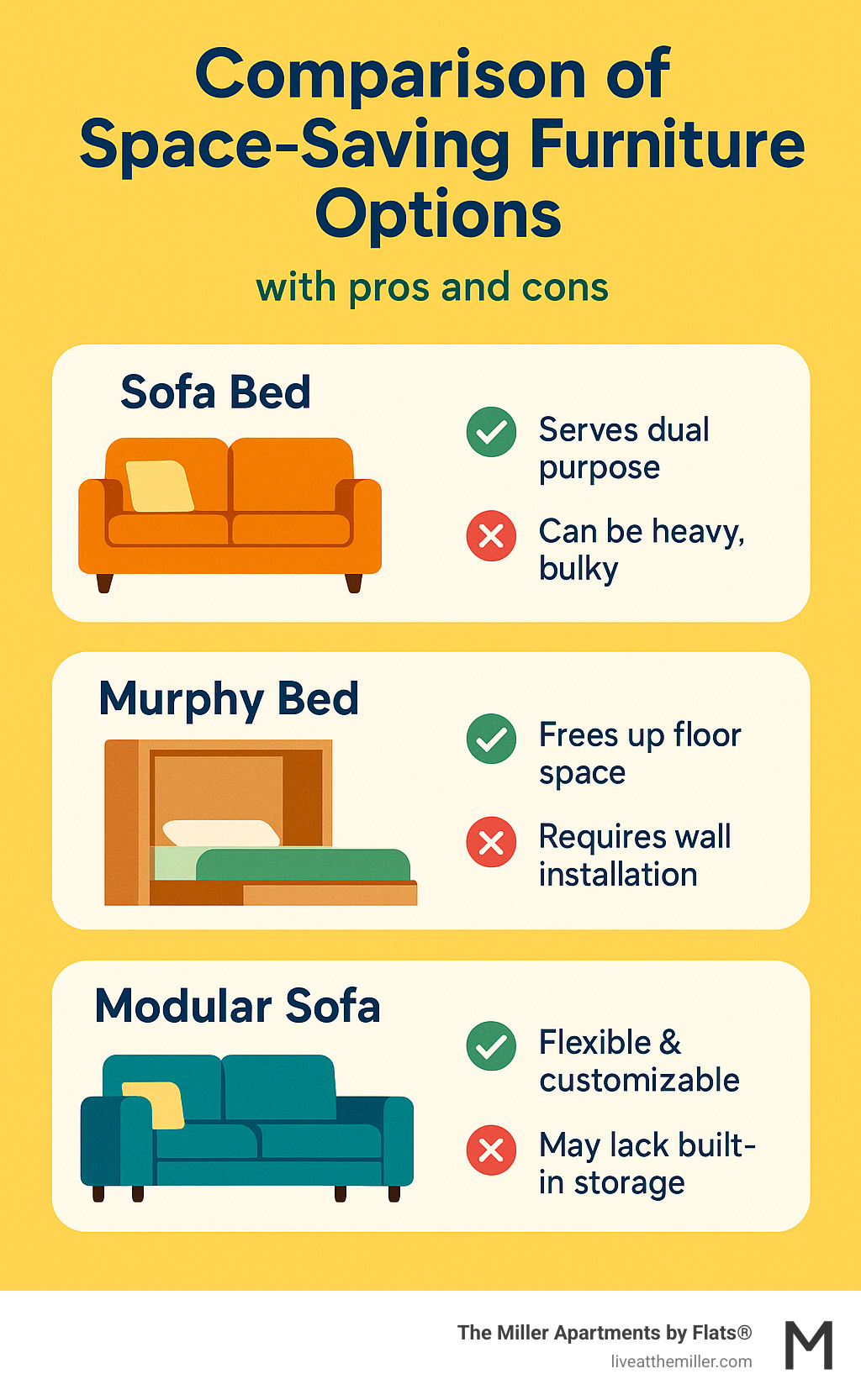
Choose Right-Sized Pieces, Not Tiny Ones
Here's a surprising truth: tiny furniture often makes small spaces feel smaller. Instead of filling your apartment with miniature pieces, opt for fewer, properly scaled items that actually work for your lifestyle.
"The biggest mistake I see in small apartments is too many small pieces creating visual clutter," shares a design expert from House Beautiful. "One larger sofa creates a more spacious feel than three tiny chairs."
When shopping, prioritize furniture with:
Leggy frames that allow light to flow underneath, creating an airy feel without sacrificing function. A sofa with 6-inch legs can make a small living room feel significantly more open than one that sits directly on the floor.
Clear or acrylic components that provide function without visual weight. An acrylic coffee table, for instance, practically disappears while still giving you somewhere to set your coffee mug.
Proportionate scale to your room. One statement piece often works better than multiple small items competing for attention.
Double-Duty Dining & Work Surfaces
Finding space for both eating and working presents a unique challenge in compact homes. These clever solutions handle both with ease:
Drop-leaf tables expand for dinner parties and collapse when you need floor space for yoga or dance parties. Wall-mounted versions take this space-saving magic even further.
Kitchen islands on casters add prep space that rolls away when not needed. Many residents at The Miller draw inspiration from the flexible furniture arrangements in the amenity spaces, bringing similar ideas into their own homes.
Wall-mounted desks fold away after work hours, instantly transitioning your space from office to living room. The best designs look like stylish cabinets when closed, maintaining your apartment's aesthetic even when you're not working.
In small spaces, flexibility is your best friend. Furniture that adapts to your changing needs throughout the day makes your apartment feel twice as large—without adding a single square foot.
3. Color, Light & Reflective Magic
Creating the illusion of space doesn't require moving walls—it just takes some clever visual tricks with color and light. In small apartments, these elements become your secret weapons for making rooms feel twice their actual size.
Light walls work wonders in compact spaces, and for good reason. They bounce natural light around the room, instantly making your apartment feel airier and more open. According to Real Simple, simply choosing lighter paint colors can make your small apartment feel up to 30% brighter—that's a huge difference without changing a single structural element!
When planning your color scheme, consider going monochrome. When your walls, trim, and ceiling share the same color family, the eye doesn't stop at boundaries, creating a seamless flow that makes the space feel larger. This doesn't mean your apartment has to be boring—subtle variations in shade add depth while maintaining that expansive feel.
Want to add some sparkle? Metallic accents act like mini-mirrors, reflecting light throughout your space. A brass lamp base, silver picture frames, or gold decorative objects can brighten dark corners without taking up precious floor space.
Perhaps the most powerful tool in your small-space arsenal is the humble mirror. Strategically placing a mirror opposite a window creates magic—doubling the natural light and visually extending your room. The Spruce notes this simple trick can make a small apartment living room appear up to twice as large!
Don't overlook the power of high-shine finishes on furniture and fixtures. In a stunning Vancouver apartment renovation featured on Christina Loucks' reflective design tips, high-gloss cabinet fronts transformed a tiny kitchen by bouncing light around the space. The result? A kitchen that felt twice its actual size.
Layered LEDs offer flexible lighting without bulky fixtures. Tucking strip lighting under cabinets, behind your TV, or along ceiling edges adds dimension to your space while keeping surfaces clear for other uses. Plus, they're easy to install and remove when it's time to move.
Here's a window trick that designers swear by: hanging curtains higher and wider than your actual window frame makes windows appear significantly larger. The Spruce points out that mounting curtain rods closer to the ceiling can make windows look up to 50% taller—instantly boosting your room's perceived height.
Stretch Space With Strategic Lighting
Poor lighting can make even spacious rooms feel cave-like, so imagine what it does to small spaces! The right lighting approach can completely transform your apartment's feel.
Think in terms of lumens layering—using multiple light sources at different heights to eliminate shadows and create dimension. Aim for at least three sources in each room: perhaps overhead lighting, a floor lamp, and some task lighting for specific activities.
Wall sconces free up valuable surface space by moving lighting fixtures to your walls. The good news for renters? Modern plug-in versions don't require any permanent wiring. They add style and function without risking your security deposit.
Want to draw attention away from limited square footage? Install a statement pendant that pulls the eye upward. One designer I know always says, "Go bold with a chandelier—it creates a focal point that distracts from the room's small dimensions while emphasizing ceiling height."
For windows, consider sheer shades that filter light without blocking it completely. They provide privacy while maximizing the natural light that's so crucial in small spaces.
Paint & Palette Rules for Tiny Rooms
Color choices can dramatically impact how spacious your apartment feels. Here are some tried-and-true approaches:
The 30-70 color rule provides perfect balance in small spaces: use 70% neutral tones as your base and 30% accent colors to add personality without overwhelming the space. This creates visual interest without making your apartment feel cluttered or chaotic.
Try the ceiling wrap technique—painting your ceiling the same color as your walls. This eliminates the harsh visual cutoff that can make ceilings feel lower and rooms feel smaller. The continuous color creates a cocoon-like effect that's surprisingly spacious-feeling.
Contrary to popular belief, bold monochrome approaches can work beautifully in small spaces. As one designer cleverly puts it: "Just because a room is small doesn't mean it needs to be all white—but bolder hues work best when the entire room—walls and ceiling—are enveloped in the same color." This creates a jewel-box effect that's both cozy and expansive.
For renters, peel-and-stick wallpaper and tile offer temporary color solutions that won't damage walls. These products have come a long way in recent years, with designs that convincingly mimic permanent installations while being completely removable. Perfect for adding personality to apartments at The Miller without sacrificing your security deposit!
4. Vertical & Hidden Storage Solutions
When you're short on floor space, looking up becomes your best strategy. Vertical storage solutions let you maximize every inch without crowding your limited floor area.
Floating shelves offer a sleek alternative to bulky bookcases. Real Simple points out that switching to floating shelves can free up to 15% more floor space in small apartments – that's significant breathing room in a compact home!
Built-ins around architectural features transform awkward spaces into storage gold mines. "When working within small spaces, every inch matters! Built-in elements can maximize usable space and make a world of difference," shares designer Alexis Pew. Think window seats with drawers or custom shelving that hugs your doorframes.
Under-bed drawers put that often-wasted space to work. Many residents at The Miller have finded that platform beds with built-in storage can completely eliminate the need for separate dressers, instantly opening up their bedroom layout.
Tall cabinets that stretch to the ceiling capture valuable upper space. In one Vancouver apartment makeover, replacing standard-height kitchen cabinets with ceiling-height units boosted storage capacity by nearly 30% – all without taking up an extra inch of floor space.
Over-door racks and hooks transform dead space into functional storage zones for everything from shoes to cleaning supplies. These small additions can make a surprisingly big difference in your daily organization.
Concealed appliances behind cabinet panels maintain a clean, uncluttered look. This technique creates visual continuity in small kitchens, making the space feel larger and more cohesive.
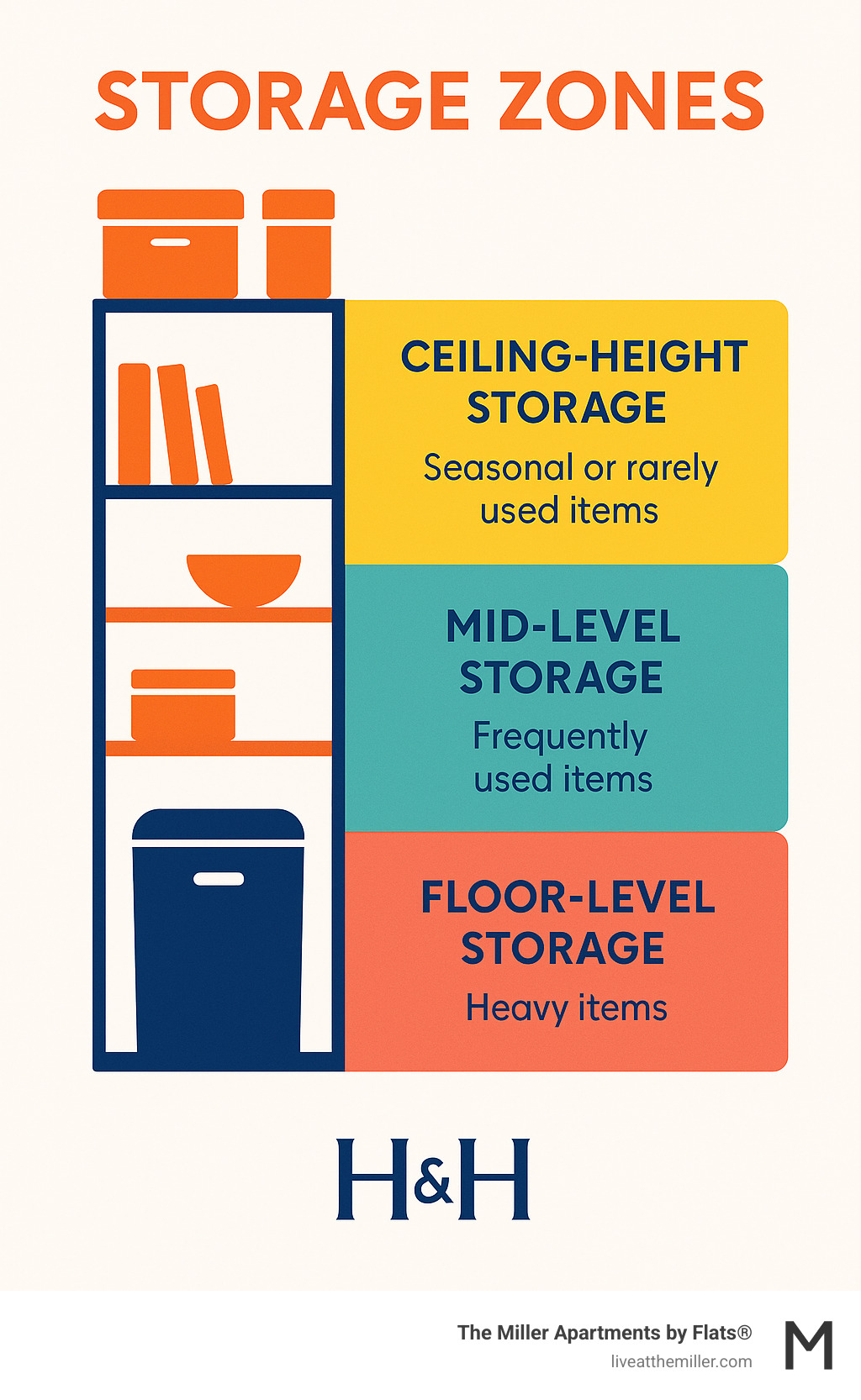
Turn Walls Into Working Surfaces
Your walls can do so much more than just display art – they can become functional powerhouses in your small apartment:
Pegboards offer endless customization for kitchens, home offices, or craft areas. Today's versions come in stylish finishes that look intentionally designed rather than borrowed from a garage workshop. Try painting your pegboard to match your wall color for a seamless look with maximum functionality.
Magnetic strips keep knives, spice jars, or office supplies organized and within reach without hogging drawer or counter space. These simple additions can transform how you use your kitchen or workspace.
Art ledges display your collections while taking up minimal wall depth. They're perfect for rotating displays that keep your space feeling fresh without the commitment of hanging and rehanging frames. Plus, they make it super easy to swap out seasonal decor.
Plant rails transform ordinary walls into lush vertical gardens. Beyond adding life and color to your space, plants improve air quality – a huge benefit in small apartments. Many residents featured in The Miller's gallery have acceptd vertical plantings as both decor and wellness improvers.
Secret Compartments & Sleek Closets
Channel your inner tiny house designer and hunt for hidden storage opportunities throughout your apartment:
Toe-kick drawers use the dead space under kitchen cabinets for storing rarely-used items like baking sheets or special occasion serving platters. These shallow drawers are perfect for flat items that otherwise eat up valuable cabinet space.
Sliding panels can neatly conceal storage, appliances, or even an entire workspace when not in use. In one clever 28m² Madrid apartment, a sliding translucent glass partition transforms the living room into a private bedroom while maintaining light flow throughout the space.
Mirrored cabinetry performs double duty by providing storage while visually expanding your space. In bathrooms or bedrooms, mirrored medicine cabinets or wardrobes work particularly well to create depth while hiding your essentials. The reflective surfaces bounce light around, making even the smallest rooms feel more open and bright.
5. Style Without Commitment: Renter- & Budget-Friendly Upgrades
Let's face it—most of us want a stylish space without risking our security deposit or emptying our bank accounts. The good news? Creating a personalized apartment doesn't require permanent changes or designer budgets.
Temporary changes are the name of the game in rental spaces. Removable wallpaper has completely changed the decorating landscape for renters. Gone are the days of bland, beige walls—today's peel-and-stick options come in sophisticated patterns that look just like traditional wallpaper but remove cleanly when moving day arrives.
The kitchen and bathroom are often the trickiest spaces to personalize in a rental, but stick-on tiles offer an ingenious solution. These water-resistant, durable adhesives can create a stunning backsplash or accent wall without a single drop of grout or glue.
Never underestimate the power of hardware swaps on existing cabinets and drawers. This five-minute fix can transform dated kitchens and bathrooms into something that feels much more current. Just keep those original knobs and pulls in a labeled bag for when it's time to move!
Walls feeling a bit lifeless? Create an art swap system with adjustable hanging hardware that makes it easy to refresh your space seasonally. Think of your walls as a gallery that evolves with your mood and the seasons.
Nothing breathes life into a small apartment quite like plants. Beyond their aesthetic appeal, they improve air quality and create a sense of nurturing that makes any space feel more like home. From tiny succulents to dramatic floor plants, greenery adds dimension to even the smallest corners.
The thrill of the hunt makes thrifted finds extra special in your space. As one resident at The Miller shared: "The satisfaction of responding 'Oh, it's vintage' when a guest admires a piece highlights the charm of integrating true vintage furniture." These pre-loved treasures often offer better quality and more character than new budget pieces.
For the creatively inclined, DIY hacks allow you to customize standard pieces to fit your exact needs. Transform that basic IKEA bookcase into a stunning built-in window seat, or give new life to a simple dresser with fresh paint and upgraded hardware.
Top 5 Under-$50 Upgrades for Small Apartments
- Command hooks and picture-hanging strips for damage-free wall decor
- LED strip lights for under-cabinet or ambient lighting
- Tension rods and clip rings for temporary curtains
- Decorative baskets and bins for stylish visible storage
- Furniture risers to create under-bed storage space
Personalize Without Clutter
In small spaces, curation beats accumulation every time. Curated collections displayed thoughtfully make a much stronger statement than scattered knickknacks. Group similar items together and give them breathing room—three well-chosen objects on a shelf create more impact than ten crowded ones.
Color creates cohesion in compact quarters. Rather than introducing every hue you love, choose cohesive color accents and repeat them intentionally throughout your space. This creates a sense of purpose and unity that makes small spaces feel designed rather than accidental.
Don't forget the power of touch in your design. Texture layering adds richness and dimension without consuming precious square footage. Mix smooth ceramics with rough-hewn wood, plush textiles with sleek metals, and watch your space come alive with tactile interest.
Embracing sustainability not only benefits the planet but often results in a more thoughtfully curated home. Quality over quantity is a principle that serves small spaces exceptionally well. The Miller Apartments demonstrates this philosophy in its community spaces, which prospective residents can explore through virtual tours before implementing similar approaches in their own apartments.
Personalizing your space isn't about filling every corner—it's about making thoughtful choices that reflect who you are. When every item has meaning, even the smallest apartment becomes a true home that tells your unique story.
Frequently Asked Questions about Small-Apartment Modern Design
How do I make a small living room feel larger?
Creating the illusion of space in a compact living room is all about smart visual tricks and thoughtful arrangements. First and foremost, keep your sight lines clear across the room—this means avoiding tall furniture pieces that create visual barriers and make your space feel chopped up.
Accept a light color palette for your walls, large furniture, and flooring. These brighter tones reflect light naturally, pushing your walls outward visually. Speaking of reflection, strategically placed mirrors work magic in small spaces! Positioning a mirror opposite a window multiplies natural light and creates a sense of depth that can make your room feel twice as large.
When it comes to furniture, bigger can actually be better. One appropriately scaled sofa creates a cleaner look than multiple smaller seating options that can make your space feel cluttered and chaotic.
Want to make your windows appear grander? Hang your curtains high and wide beyond the window frame. This simple trick can make windows look up to 50% taller according to design experts at The Spruce, instantly elevating your ceiling height visually.
For coffee and side tables, consider pieces with glass or acrylic elements that visually "disappear" in your space while still providing the function you need. Finally, be ruthless about reducing visual clutter—in small spaces, every decorative object should earn its keep by being meaningful or serving a purpose.
Which multifunctional furniture pieces give the biggest payoff?
Not all space-saving furniture is created equal when it comes to maximizing small apartments. If you're going to invest in multifunctional pieces, focus on these high-impact options:
Storage beds are absolute game-changers in small apartments. By utilizing the space beneath your mattress—an area that would otherwise go wasted—you can potentially eliminate the need for a separate dresser altogether. At The Miller Apartments, residents often find that upgrading to a quality storage bed frees up enough floor space to create a cozy reading nook or home office area.
For those who occasionally host dinner parties but don't need a large table daily, extendable dining tables offer the perfect compromise. These clever pieces can shrink down for everyday use and expand when company arrives, giving you flexibility without sacrificing precious square footage.
Nesting tables provide versatile surface area that adapts to your changing needs. Tuck them together when space is tight, then spread them out when friends come over for game night or appetizers.
If you're working from home in a small space, wall-mounted desks that fold away completely when not in use let you reclaim that floor space for living in the evenings and on weekends.
Finally, don't underestimate the humble storage ottoman. These hardworking pieces serve as seating, footrests, occasional tables, and hidden storage compartments—all while looking stylish in your space.
The key is selecting pieces that align with your specific lifestyle. Think about how you actually use your space day-to-day and prioritize accordingly.
What mistakes should I avoid when choosing colors for tiny spaces?
Color choices can make or break a small apartment, and there are several common pitfalls to watch out for when planning your palette:
Using too many different colors without a cohesive plan is perhaps the biggest mistake. This creates visual chaos that makes your space feel cluttered and disjointed. Instead, develop a whole-apartment color strategy with a limited palette that flows naturally from room to room.
Another misstep is choosing colors based solely on trends rather than considering the specific light conditions in your apartment. That gorgeous dark teal that looked amazing on Pinterest might make your north-facing living room feel like a cave if natural light is limited.
Be mindful of creating harsh transitions between rooms or zones. Abrupt color changes visually chop up your space, while subtle transitions help it feel larger and more cohesive. This is especially important in open-concept apartments where different functional areas share visual space.
Many people focus on wall color but end up neglecting the ceiling as part of their color scheme. Your ceiling is essentially your fifth wall—painting it the same color as your walls (or a lighter tint of the same hue) can blur boundaries and make rooms feel taller.
Finally, be strategic with gloss finishes. While they do reflect light beautifully, high-shine paints also highlight every imperfection in your walls. In older apartments with character (and quirks), a matte or eggshell finish might be more forgiving.
Before committing to any color scheme, test your choices under both natural daylight and your apartment's evening lighting. Colors can shift dramatically depending on light sources, and what looks perfect during a sunny afternoon might feel completely different under LED lighting at night.
Conclusion
Designing a small apartment is truly an exercise in intentionality. When every square inch counts, each decision you make—from furniture selection to wall color—shapes how your space functions and feels. But here's the beautiful truth: these constraints often spark the most creative and personalized solutions.
Modern interior design ideas for small apartments continue to evolve as urban living becomes increasingly compact. The most successful spaces blend practical optimization with personal expression, creating homes that feel both functional and uniquely yours.
Have you ever noticed how a thoughtfully designed small space often feels more comfortable than a poorly organized large one? By implementing the strategies we've explored—multifunctional furniture, strategic color and lighting, vertical storage, and renter-friendly customizations—you can transform even the most compact apartment into a home that feels spacious, stylish, and perfectly custom to your lifestyle.
At The Miller Apartments in Vancouver, WA, residents have finded that modern design principles can work wonders in compact spaces. The community's thoughtful approach to design flows through its amenities and floor plans, showing how small spaces can live large with the right techniques.
Your small space isn't just somewhere you live—it's a canvas for creative problem-solving and personal expression. With the right approach, limitations become opportunities to refine what truly matters in your home environment.
Ready to see these small-space design principles in action? Schedule a Tour of The Miller Apartments to explore how modern design maximizes both style and function in apartment living. You might be surprised at just how spacious a well-designed apartment can feel, regardless of its square footage.
After all, good design isn't about how much space you have—it's about how intelligently you use it.
